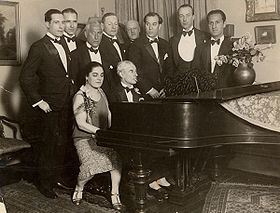Recently at Maverick Concerts the Music Director, Alexander Platt, introduced Ravel’s “Gaspard de la Nuit” and mentioned that Ravel was a “great virtuoso pianist.” This is a common idea but it’s wrong, interestingly wrong.
According to the accounts I have read, Ravel was not a particularly devoted piano student during his conservatory years. What efforts he did extend were mostly towards developing his compositional technique, which remained a lifelong obsession. “My objective,” he once wrote, “is technical perfection. I can strive unceasingly to this end, since I am certain of never being able to attain it. The important thing is to get nearer to it all the time.” Ravel also made unusually detailed studies of the capacities and qualities of musical instruments, which resulted in his becoming a great master orchestrator.
Ravel became merely a competent pianist. He was unwilling to put in the endless hours of practice that would have made him a virtuoso, and we are all the better for that. Certainly it would be useful and inspiring to have recordings of Ravel playing his own piano masterpieces–if he could have played them well. But he couldn’t. He rarely if ever played them in public, and he never played his piano concertos.
Ravel is not the only composer who was unable to play his own compositions. Henry Cowell’s widow once told me that her husband did OK with his avant-garde piano pieces (some of which he recorded successfully) because they weren’t very difficult to play. But he couldn’t play the piano part of his Violin Sonata when it was recorded. There are many stories about how Robert Schumann ruined a potential career as a virtuoso when he damaged his hand using a machine intended to increase the independence of his fingers. But Schumann had never been a serious piano student and never planned on a virtuoso’s career.
In all of these cases, the composers understood the technique of the piano well enough to write in innovative and imaginative ways for it. I can sympathize with how this works. In my own piano playing days, I would sometimes read through such demanding pieces as Prokofiev’s Toccata or Brahms’s arrangement of the Bach Chaconne for left hand alone. I couldn’t have played these pieces if I had practiced them for years. But I was able to learn how they worked.
During Ravel’s lifetime there was enough demand for his music so that recordings by the composer would have sold well. This demand led to two instances I know of in which recordings were deliberately and fraudulently presented as Ravel’s own when they were not. Ravel’s only recordings as a pianist were as accompanist for the singer Madeleine Grey. He never made records of his solo piano works. He did make some piano rolls, a medium in which mistakes were easy to correct. But the pianist Gaby Casadesus admitted years after the fact that when the more difficult Ravel pieces were recorded on piano rolls her husband Robert had done the playing, and the Duo-Art company issued them under Ravel’s name.
Ravel wasn’t a very accomplished conductor, either. He made only two recordings as conductor, and they are valuable for their musical insights. (More on this in a moment.) But when the French branch of HMV recorded his Piano Concerto, with the pianist for whom he had written it (the wonderful Marguerite Long), they hired the Portuguese conductor Pedro de Freitas Branco to conduct the pick-up orchestra and put Ravel’s name on the records as conductor. The deception was uncovered many years later, in the company’s archives. (Freitas Branco was credited as the conductor of the “filler” on side 6 of the 78 rpm set.)
So what is the value of Ravel’s recordings? Obviously, the atmosphere in the song recordings is authentic, and Grey was a superb singer. One of the recordings of Ravel conducting, his “Introduction and Allegro,” is an acoustical recording, made in England in 1923. Its fidelity is limited, and the English musicians involved were probably not very familiar with the music or the style, so it’s not a great experience.
However, Ravel’s other recording, “Boléro,” made in 1930 with the Lamoureux Orchestra, is a revelation. Technically, it’s not very accomplished. Although the orchestra was one of France’s best, it doesn’t play with fine precision, probably due to the limitations of the conductor. But the musical interpretation shows us what Ravel intended in his repetitious work, and it’s not as boring as it usually sounds. Ravel was famously quoted as saying, “There is no music in it.” But the slow tempo he takes allows the scoring to sound in a most convincing way, and the inflections he draws from the solo instrumentalists are fascinating. Apparently the conductor Riccardo Muti feels the same way I do, because his EMI CD of “Bolero” is a close copy of Ravel’s interpretation.
Obviously a composer doesn’t have to be able to play or conduct all of his or her own music. That doesn’t take anything away from the music, of course. I do love to hear composer-virtuosi, like Rachmaninov, Prokofiev, Sarasate, Leon Kirchner, and others, performing their own works. But I’ll never hear Bach perform and I still love his music.

September 5th, 2012 at 10:43 am
I’m not certain, but I think the Bolero was conducted by Albert Wolff, a much neglected figure.
September 5th, 2012 at 10:49 am
This would not surprise me if it were true. But the accounts I’ve seen point to Ravel as actually having conducted this one. There is no doubt that Ravel was active as a conductor. He led numerous performances with major orchestras when he was in the U.S. So he could conduct when necessary.